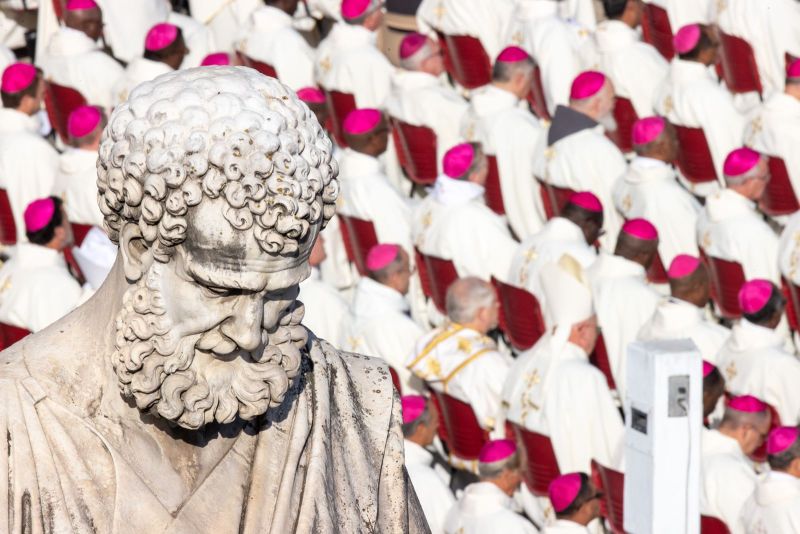 The opening Mass of the Synod on Synodality in St. Peter’s Square on Oct. 4, 2023. / Daniel Ibanez/CNA
The opening Mass of the Synod on Synodality in St. Peter’s Square on Oct. 4, 2023. / Daniel Ibanez/CNA
Vatican City, Oct 4, 2023 / 04:15 am (CNA).
Pope Francis opened the Synod on Synodality’s three-week assembly on Wednesday with a call to remember that the Church exists to bring Jesus to the world and should face today’s challenges with a gaze fixed on God rather than “political calculations or ideological battles.”
Speaking in St. Peter’s Square for the synod’s opening Mass on Oct. 4, Pope Francis underlined that “the primary task of the synod” is to “refocus our gaze on God, to be a Church that looks mercifully at humanity.”
“We do not want to make ourselves attractive in the eyes of the world, but to reach out to it with the consolation of the Gospel, to bear witness to God’s infinite love in a better way and to everyone,” he said.
The pope presided over Mass on the feast of St. Francis of Assisi, concelebrated by nearly 500 priests, bishops, and cardinals, including 20 of the Catholic Church’s newest cardinals.
Recalling the Lord’s words to St. Francis, “Go, rebuild my Church,” Pope Francis said that the synod serves as a reminder that “our Mother the Church is always in need of purification, of being ‘repaired,’ for we are a people made up of forgiven sinners … always in need of returning to the source that is Jesus and putting ourselves back on the paths of the Spirit to reach everyone with his Gospel.”
Pope Francis highlighted a question raised by Benedict XVI at the 2012 Synod of Bishops as the “fundamental question” facing the synod: “‘The question for us is this: God has spoken, he has truly broken the great silence, he has shown himself, but how can we communicate this reality to the people of today, so that it becomes salvation?’”
Francis repeated that the synod is not “a political gathering” or a “polarized parliament,” but “a place of grace and communion.”
“Dear brother cardinals, brother bishops, sisters and brothers, we are at the opening of the General Assembly of the Synod. Here we do not need a purely natural vision, made up of human strategies, political calculations, or ideological battles. We are not here to carry out a parliamentary meeting or a plan of reformation. No. We are here to walk together with the gaze of Jesus, who blesses the Father and welcomes those who are weary and oppressed,” he said.
The 9 a.m. Mass began under bright sunshine and a soft breeze with a procession through St. Peter’s Square of the delegates in the XVI Ordinary Synod of Bishops, which for the first time includes laymen and women as full voting members.
The synod delegates will meet in the Vatican’s Paul VI Hall Oct. 4-29 to advise the pope on the theme: “For a Synodal Church: Communion, Participation, Mission.” The three-week assembly is the first of the two-part Synod on Synodality that will conclude in 2024.
The Vatican choir led the crowd in the solemn “Laudes Regiæ” hymn, singing “Christ conquers, Christ reigns, Christ commands” in Latin with the “Litany of the Saints.”
The Prayer of the Faithful included a prayer that the Lord will “grant those participating in the work of the synod hearts open to the inspiration of the Holy Spirit, a readiness to listen to their brothers and sisters, and concern for the needs of the Church in today’s world.”
In his homily, Pope Francis outlined his vision for a synodal Church, saying Jesus wants “a Church that is united and fraternal … that listens and dialogues … that blesses and encourages, that helps those who seek the Lord, that lovingly stirs up the indifferent, that opens paths in order to draw people into the beauty of faith … that has God at its center and, therefore, is not divided internally and is never harsh externally.”
He urged people to imitate St. Francis, who lived at a time of “great struggles and divisions … between the institutional Church and heretical currents,” but did not criticize or “lash out” at anyone, choosing instead to take up “only the weapons of the Gospel, which are humility and unity, prayer and charity.”
The pope warned of three dangerous temptations facing the Church today: “of being a rigid Church … which arms itself against the world and looks backwards, of being a lukewarm Church, which surrenders to the fashions of the world, and of being a tired Church, turned in on itself.”
“Jesus’ blessing gaze invites us to be a Church that does not face today’s challenges and problems with a divisive and contentious spirit but, on the contrary, turns its eyes to God who is communion and, with awe and humility, blesses and adores him, recognizing him as its only Lord. We belong to him and – let us remember – we exist only to bring Him to the world,” Pope Francis said.
Following the Mass, the synod delegates will take part in the First General Congregation of the XVI Ordinary General Assembly of the Synod of Bishops, where Pope Francis, Cardinal Mario Grech, and Cardinal Jean-Claude Hollerich will give opening speeches.
[…]









Was he in urgent need of a foot washing?
Probably an addicted nut job. But the incident presents the question of how a simple car can crash through two gates. It would appear that a strengthening of security is in order at the gates. . This is especially true since within living memory an assassination attempt was made on Pope JP2, although in a different manner. Time to harden defenses.
What happened to “inclusiveness”? And since Francis believes in “building bridges and not walls” shouldn’t there be two large ramps that bridge over the gate to the Vatican entrance so an invading vehicle can enter safely without getting its tires shot out?